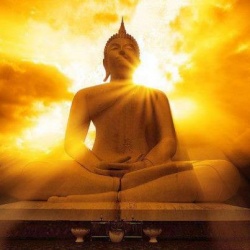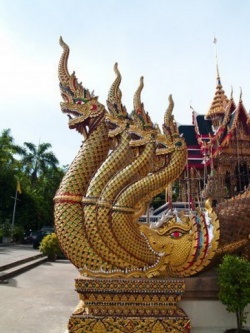The Cult of the Naga by Dr. Htin Aung
The Cult of the Naga* was the one pre-Buddhist cult which did not recover from Anawrahta's suppression. At the present day the Naga is not worshipped at all, and there remain only two faint traces** of the original cult. As part of the initiation ceremony, the Burmese boy is 'shown' to the Naga at the western gate of an Upper Burmese village, and people avoid, as much as possible, going in a direction which is not 'according to the Naga's head'. In the first, second and twelfth months of the Burmese year, the Naga's head is turned to wards the west, with the tail pointing east. In the sixth, seventh and eighth months this process is reversed. In the third, fourth and fifth months the head faces the north and the tail the south. This process is reversed in the ninth, tenth and eleventh months.
If one goes into the Naga's mouth, disaster will result, and if one goes against the direction of the Naga's scales, ill-luck will follow; for example, during the months in which the Naga's head is turned towards the east, one must absolutely avoid journeys from due east to due west, and avoid as much as possible journeys from due west to due east. The origin of the belief can no longer be traced and it is not possible to know, or even guess, which particular Naga is being referred to: in fact, if is not even known whether this Naga is in the sky or at the bottom of the ocean, or in the bowels of the earth.
As has been stated above, the worship of the Naga was prevalent in the kingdom of Tagaung. The Burmese Naga is similar in many ways to the Indian Naga and the Chinese Dragon, hut it is difficult to say whether the worship of the Naga was originally a native cult or borrowed from the neighbouring regions of Manipur and Yunnan. Moreover, the worship of the Naga could have developed from the worship of the snake and, as has been noted above, in the Shan state and at Popa there are traces of a snake-cult. However, in these regions it is not so much the snakes, but their Nat masters who are worshipped. Thus, the Burmese snake-charmer goes to the Popa region, makes his offerings to the Popa Nats, promises to bring back the snakes within three years, and then proceeds to trap some cobras. The Burmese consider the Naga to be half animal and half spirit and do not identify it with the snake, with the result that, unlike the Southern Indians, they set upon and kill snakes, including cobras, whenever they find them.
The Burmese Naga is dangerous when angered, and its mere frown turns the human being into ashes. Even when not angry its breath can blind a human being as it is so hot. It can assume human form and, on the whole, it is a benevolent being. The Burmese believe that Nagas live at the bottom of deep rivers, seas and oceans and in the bowels of the earth. Although they can fly in the air they do not do so too often because they will become exposed to attacks from their eternal enemies, the galon (garuda) birds. Just as the great Asoka of India had Naga retainers, an early king of Pagan was, according to the Chronicles, attended by an army of Naga youths. Naga workmen helped in the building of a palace at Tagaung and, when the palace was completed, the king of the Nagas himself assisted in the coronation ceremonies of the king. A Naga king assisted in the foundation of the city of Prome and gave his daughter as a second queen to the king, Duttabaung, together with a wondrous ocean going boat covered with Naga's scales. However, towards the end of his reign there was a quarrel between the Nagas and the king, and as he was travelling in the boat near the seaport of Bassein, the Nagas appeared from below a whirlpool and took back their boat, with the result that the king was drowned. The whirlpool still exists at the present day and it is called the 'whirlpool of 'Naga-yit', which means 'where the Nagas twist and turn'. One of the early kings of Pagan, the hero Pyusawhti, was the ward of a Naga king and queen who lived in a hole in a garden on the side of a hill, and who were worshipped with offerings of food and flowers by the people of the nearby villages. The king of Pagan, Nyaung-u Sawrahan, whom Anawrahta's father dethroned, built Buddhist temples, but he also set up the image of a Naga in a garden for worship.'
The cult of the Naga did not reappear after the death of Anawrahta, because long before A.D. 1056 Buddhist literature had modified the pre-Buddhist conception of the Naga, and the Nagas were shown to be adherents of Buddhism and devout worshippers of the Buddha. The Naga tradition in Buddhism began with an episode in the life of the Buddha. After attaining Buddhahood, the Buddha spent seven weeks in continuous meditation in the vicinity of the Bodhi Tree, and the sixth of the seven weeks was spent on the shore of the Mucalinda Lake***, a few yards away from the Tree; there blew a great storm, and the Naga king, who lived in a tree nearby, sheltered the Buddha by winding his coils seven times round the meditating Buddha's body and holding his hood over the Buddha's head. The depiction of the meditating Buddha protected by the coils of the Naga king later became a popular motif in Buddhist art and sculpture. The Buddha subdued one fierce Naga near a hermitage, and later the Great Naga who lived on Mount Mayyu. A Naga king was present when the relics of the Buddha were being distributed after the cremation of the body. In the Buddhist literature of Ceylon, the Naga appeared often. The Buddha made a special visit to the north of Ceylon to bring peace between the Nagas who were fighting among themselves. When the Branch of the Bodhi Tree was being brought to Ceylon by sea, the Nagas wanted it for themselves, but still afforded protection to the ship bringing the Branch. When 'the Great Temple' was being built in Ceylon to enshrine some relies of the Buddha, the Nagas contributed the relics in their possession. In the face of such established Buddhist tradition the Burmese Naga could no longer be worshipped separately from the Buddha.
Kyansittha attempted to bring the cult under his control by announcing that when he was hiding from the wrath of Anawrahta, he was sheltered by a Naga lad. He later named the particular place where this incident took place. Modern scholars have tried to give a rational explanation to this episode in Kyansittha's life by explaining that it was not a Naga but a cobra that Kyansittha was referring to, or that it was a young attendant from a nearby temple devoted to Naga worship that gave Kyansittha protection. However, such explanations are unnecessary when we remember Kyansittha's contention that he was a reincarnation of Vishnu and that he was a fellow-worshipper, in a previous existence, with the Lord of the Great Mountain. Just as he allowed the builders of his palace to devote one whole day to ceremonies connected with the worship of the Lord of the Great Mountain and one whole day to those connected with Vishnu, so he permitted them to devote a whole day to ceremonies involving the worship of the Nagas. But although many of his courtiers themselves took part in the ceremonies held by the builders to propitiate the Nagas who had been disturbed when the foundations of the palace were laid, there was no popular revival of the Naga cult.
When Kyansittha later found that the people had accepted the new Buddhist conception of the Naga, he built a beautiful pagoda at the place where he was supposed to have been protected by the Naga lad, and named it 'the 'Naga-yone' meaning 'robed by the Naga', referring to the 'robing' of the Buddha by the Naga Mucalinda's coils. Later on, the name 'Naga-yone' became a term to describe an image of the Buddha with the coils of the Naga round his body, or a pagoda with large Naga figures around it. In fact, up to the present day the Naga is the most popular motif in Burmese art, both religious and secular.
.* Naga: big snake-like creature)
.** In addition to local traces at Tagaung, Popa and Shan States, as already mentioned above.
.*** The Naga's name was Mucalinda, hence the name of the lake.

